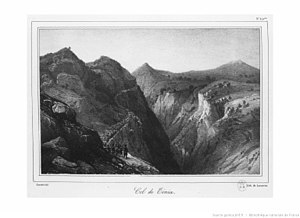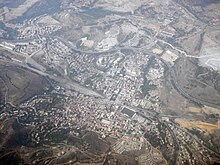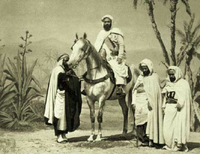Battle of the Col des Beni Aïcha
| |||||||||||||||||||||||||||
Read other articles:

بلدة بريلي الإحداثيات 45°01′46″N 84°10′51″W / 45.029444444444°N 84.180833333333°W / 45.029444444444; -84.180833333333 تقسيم إداري البلد الولايات المتحدة[1] التقسيم الأعلى مقاطعة مونتمورنسي خصائص جغرافية المساحة 70.3 ميل مربع عدد السكان عدد السكان 1697 (1 أبريل 2020)[2]1860 (1 أ…

Este artículo o sección necesita referencias que aparezcan en una publicación acreditada.Este aviso fue puesto el 25 de diciembre de 2019. Ilustración del poema Lotta Svärd. Lotta Svärd (en sueco: svärd; significa una espada) es el cuarto poema de la segunda parte del poema épico de Johan Ludvig Runeberg, Las Historias del Alférez Ståhl, de 1860. El poema de Lotta Svärd trata sobre una mujer que sirvió en una cocina de campo durante la Guerra de Finlandia. El nombre se usó más tard…

For other uses, see Robbers Roost (disambiguation). HideoutRobbers Roost, UtahHideoutCoordinates: 38°19′14″N 110°32′08″W / 38.32056°N 110.53556°W / 38.32056; -110.53556 Upper Robbers Roost Canyon, aerial photo. The Robbers Roost was an outlaw hideout in southeastern Utah used mostly by Butch Cassidy and his Wild Bunch gang in the closing years of the Old West.[1] The hideout was considered ideal because of the rough terrain. It was easily defended, dif…

لمعانٍ أخرى، طالع شجاع (توضيح). شجاع تقسيم إداري البلد إيران إحداثيات 38°54′01″N 45°38′45″E / 38.900278°N 45.645833°E / 38.900278; 45.645833 تعديل مصدري - تعديل شجاع هي قرية في مقاطعة جلفا، إيران. عدد سكان هذه القرية هو 2,287 في سنة 2006.[1] مراجع ^ تعداد سكان جمهورية إيران ا…

ليتل تيرتل معلومات شخصية الميلاد 1752 الوفاة يوليو 14, 1812فورت واين مكان الدفن إنديانا الحياة العملية المهنة شيخ قبيلة تعديل مصدري - تعديل السلحفاة الصغيرة Little Turtle، (1747 - 14 يوليو 1812م) كان زعيم قبيلة ميامي الهندية، و كان من أشهر القادة العسكريين من ذوي الأصول الهندية …

Правда — термін, який має кілька значень. Ця сторінка значень містить посилання на статті про кожне з них.Якщо ви потрапили сюди за внутрішнім посиланням, будь ласка, поверніться та виправте його так, щоб воно вказувало безпосередньо на потрібну статтю.@ пошук посилань сам

Carl Hermann Theodor Haase, auch Karl, ab 1889 von Haase (* 19. Juli 1831 in Stralsund; † 18. November 1893 in Hamburg) war ein deutscher Unternehmer, langjähriger Pächter der Hamburger Gaswerke und Kaiserlich Persischer Generalkonsul. Inhaltsverzeichnis 1 Leben und Wirken 1.1 Familie und Nachkommen 2 Familienwappen 3 Literatur 4 Einzelnachweise Leben und Wirken Herrenhaus Wiebendorf (Bauzeichnung 1885) Herrenhaus Roggendorf (2011) Haase war der vierte Sohn von Karl Ehrenfried Haase († 4. …

|Батько= |Посада= |Діти= |Дружина= |Мати= |Чоловік= Щолкін Кирило Івановичрос. Кирилл Щёлкин Народився 17 травня 1911(1911-05-17)ТифлісПомер 8 листопада 1968(1968-11-08) (57 років)МоскваПоховання Новодівичий цвинтарКраїна СРСРДіяльність фізик-ядерникAlma mater Таврійський національний уніве

В статті наводиться перелік османських нападів, битв і облог від часів постання Османської імперії на початку XIV століття до Першої світової війни в XX ст. Карта територіального розширення Османської імперії з 1307 по 1683 рік. Зміст 1 Підйом (1299–1453) 2 Зростання (1453–1550) 3 Транс…

Clothing worn by plague doctors that was intended to protect them from infection Paul Fürst, engraving, c. 1656, of a plague doctor of Marseilles (introduced as 'Dr Beak of Rome'). His nose-case is filled with herbal material to keep off the plague.[1] The clothing worn by plague doctors was intended to protect them from airborne diseases during outbreaks of bubonic plague in Europe.[2] It is often seen as a symbol of death and disease.[3] However, the costume was …

Town in Louisiana, United StatesSt. FrancisvilleTownTown of St. FrancisvilleOne of several former plantation houses near St. FrancisvilleLocation of St. Francisville in West Feliciana Parish, Louisiana.Location of Louisiana in the United StatesCoordinates: 30°47′05″N 91°22′50″W / 30.78472°N 91.38056°W / 30.78472; -91.38056CountryUnited StatesStateLouisianaParishWest FelicianaEstablished1807Government • MayorBobbee LeakeArea[1] • …

Albanian football club Football clubKF AdaFull nameKlubi i Futbollit Ada VelipojëFounded6 March 1996; 27 years ago (1996-03-06)GroundFusha Sportive AdriatikVelipojë, AlbaniaCapacity1,200PresidentAlfred PjetriChairmanBashkia ShkoderLeagueKategoria e Tretë2022–23Kategoria e Dytë, Group A, 11th (relegated) Home colours Away colours KF Ada is an Albanian football club based in the city of Velipojë which is situated in Shkodër County. The club's home ground is the Reshit Rus…

Icelandic singer-songwriter This is an Icelandic name. The last name is a family name, but this person is referred to by the given name Laufey. LaufeyLaufey in 2021Background informationBirth nameLaufey Lín Bīng Jónsdóttir / 林冰[1]Born (1999-04-23) 23 April 1999 (age 24)Reykjavík, IcelandGenresJazz popOccupation(s)Singer-songwriterInstrumentsVocalspianoguitarcelloYears active2020–presentLabelsAWALWebsitelaufeymusic.comChinese nameTraditional Chinese林冰Simplified Ch…

Cargo and passenger ship SS Shuntien in civilian service, 1934–41 The icebreaker shape of her bow is clearly visible Photograph reproduced courtesy of WikiSwire History Hong Kong NameShuntien NamesakeShuntian, a Ming Dynasty name for Beijing Owner China Navigation Co, Ltd[1][2] Operator John Swire & Sons, Ltd Port of registry London[1] RouteShanghai – Tianjin coastal service[4] BuilderTaikoo Dockyard & Engineering Co[1][6] Yard number26…

This article does not cite any sources. Please help improve this article by adding citations to reliable sources. Unsourced material may be challenged and removed.Find sources: Nissan W64 engine – news · newspapers · books · scholar · JSTOR (November 2018) (Learn how and when to remove this template message)Reciprocating internal combustion engine Nissan W64OverviewManufacturerPrince & NissanProduction1966-1967LayoutConfiguration90° V8Displacement6,3…

تيمقاد ساحة مدينة تيمقاد خريطة البلدية الإحداثيات 35°29′45″N 6°28′02″E / 35.4958°N 6.46724°E / 35.4958; 6.46724 تقسيم إداري البلد الجزائر ولاية ولاية باتنة دائرة دائرة تيمقاد عدد السكان (2008[1]) المجموع 11٬828 معلومات أخرى منطقة زمنية ت ع م+01:00 05023 تعديل مصدري -…

Overview of the legality and practice of prostitution in South Korea Prostitution in South Korea is illegal,[1] but according to The Korea Women's Development Institute, the sex trade in Korea was estimated to amount to 14 trillion South Korean won ($13 billion) in 2007, roughly 1.6% of the nation's gross domestic product.[2][3] According to a survey conducted by the Department of Urology at the Korea University College of Medicine in 2015, 23.1% of males and 2.6% of fema…

Dieser Artikel beschreibt die Fraktion im Europäischen Parlament. Für die damit verbundene gleichnamige europäische politische Partei siehe Partei Europäische Konservative und Reformer. Europäische Konservative und Reformer Offizielle Abkürzung ECR Mitglieder 67/705 Fraktionsvorsitzende Polen Ryszard Legutko Italien Nicola Procaccini Gründung 2009 Geschichte 1973–1979 Fraktion der Europäischen Konservativen, 1979–1992 Fraktion der Europäische Demokraten, 1992–2009 …

Short story by Rex StoutBooby TrapShort story by Rex StoutIllustrated by Jane HuttenlochCountryUnited StatesLanguageEnglishGenre(s)Detective fictionPublicationPublished inThe American MagazinePublication typePeriodicalPublication dateAugust 1944SeriesNero Wolfe Booby Trap is a Nero Wolfe mystery novella by Rex Stout, first published in the August 1944 issue of The American Magazine. It first appeared in book form as the second novella in the short-story collection Not Quite Dead Enough, publ…

Lukas 23Lukas 23:14-26 pada Kitab Injil bercorak tulisan Carolingian minuscule (folio 160v; British Library, MS Add. 11848).KitabInjil LukasKategoriInjilBagian Alkitab KristenPerjanjian BaruUrutan dalamKitab Kristen3← pasal 22 pasal 24 → |right|thumb|150px|]] Lukas 23 (disingkat Luk 23) adalah pasal kedua puluh tiga Injil Lukas pada Perjanjian Baru dalam Alkitab Kristen. Disusun oleh Lukas, seorang Kristen yang merupakan teman seperjalanan Rasul Paulus.[1][2] Teks Tek…



